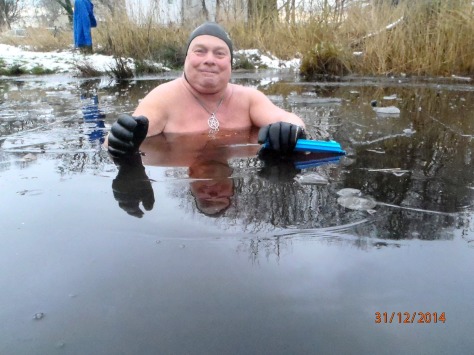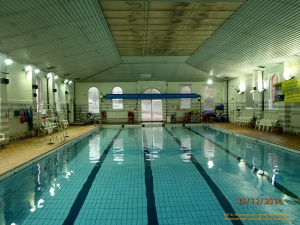Cold-water acclimatisation by ”Wildswimmer” Pete Roberts
Recent years have seen the emergence of the somewhat arduous sport of winter swimming in the UK. The desire to keep swimming outdoors without a wetsuit through typically cold, depressing British winters? Quite likely. And it’s a proven fact that winter swimmers have a higher resistance to infection, a significantly lower incidence of cancer and heart disease, together with an extended life expectancy. But isn’t jumping into cold water dangerous? What about shock and hypothermia? From what I can find, all research on the effects of immersion in cold water is posited on the “victim” having involuntarily entered the water as the result of some mishap. Very little if any of which applies to the situation where a Speedo-clad, cold hardened swimmer enters the water voluntarily. Indeed many authorities hold that water temperatures around 13C (mid-50s F) are particularly dangerous, water temperatures that seem almost tropical to swimmers hardened to the British cold.
Basically we need to put aside such “received wisdom” and start out with a clean sheet. The first point to remember is that hypothermia is not the greatest risk. Far from it. The average adult human body holds enough heat to maintain core temperature during immersion for anything up to thirty minutes before approaching borderline hypothermia. Yes, hypothermia is the silent killer, but not where a swimmer has deliberately entered cold water and in a position to exit when he wishes, dry, dress and have some warm drink or food. The real killer is cold shock, otherwise known as sudden immersion syndrome. Typical symptoms are a sharp gasp followed by uncontrollable hyperventilation, a galloping pulse and dangerously high blood pressure which in extreme cases can lead to cardiac arrest. Hyperventilation can disrupt limb co-ordination leading to the risk of drowning from loss of swimming ability. Pretty nasty. However cold hardening reduces or even suppresses the cold shock response and it must be borne in mind that cold shock is a physiological, rather than psychological process. To avoid confusion I’m going to refer to a winter swimmer’s cold training as “cold hardening” because “cold acclimatisation” has several different meanings.
A winter swimmer can swim unprotected in water so cold it would kill an non-hardened individual in minutes because of two factors:
1.) Suppression of the cold shock response.
2.) Physiological changes to the body which reduce loss of heat to ambient, while increasing the rate of internal heat production.
Cold training involves three major physiological changes. Firstly, the body lays down a layer of subcutaneous fat which acts as an internal “wetsuit”. Its only disadvantage is that you can’t take it off during hot weather! However white fat isn’t the only factor. As infants humans also carry significant amounts of brown fat which mostly disappears as we reach adulthood. However it’s been found that adults regularly exposed to extreme cold regrow their brown fat, and in swimmers the brown fat is thought to be concentrated around the heart and great blood vessels in the chest. Brown fat doesn’t act as insulation, far from it. In fact it’s now been found that brown fat (or brown adipose tissue) isn’t fat at all, but a modified form of muscle tissue whose sole function is to generate heat. When the body is cold stressed brown fat begins to “burn” the body’s stores of white (lardy) fat. Brown fat metabolism needs large amounts of oxygen which will result in respiration rates somewhat above those needed for the accompanying physical effort. The mammalian body has two responses to cold stress, the primary being brown fat metabolism, the “back up” process is involuntary muscle activity: shivering. That’s why many winter swimmers don’t shiver after exiting cold water.
Secondly, the vascular system also undertakes changes primarily intended to protect the body’s core from chilling, endangering vital organs. It develops the ability to very quickly reduce (but not completely close down) circulation to the outermost tissues, hence the cyanotic blue or purplish hue of a cold-water swimmer’s skin after a few minutes’ immersion. It must be be borne in mind that the longer the swimmer is immersed, the deeper the chilling which means that upon exit he has to behave as though he does in fact have hypothermia. The reason? The circulation to outer tissues is much reduced with the accumulation of significant quantities of pooled chilled blood. Should this cold blood suddenly enter the core circulation it can result in cardiac arrest. The phenomenon is well known as “cold drop” or “afterdrop”. To minimise any risk of afterdrop it’s vital that after leaving the water, the swimmer dries and and changes as quickly as possible, then allows the body to warm of its own accord. External heat from car heaters or hot showers can fool the body into prematurely opening up the main circulation, dumping large quantities of chilled blood into the core with possible dire consequences. Don’t go for a brisk run after a cold swim either, as exercise can have the same effect. Best way to warm up is to relax in a coffee bar or local pub with a warm drink or two, but no alcohol until fully warmed up. While on the subject of alcohol it can’t be emphasised too strongly that alcohol and winter swimming don’t mix, so no shot of rum beforehand. As well as its other detrimental effects on swimming ability, alcohol seriously impairs the body’s ability to regulate its internal temperature.
Finally, metabolism. Many winter swimmers have significant hunger after a very cold swim which implies that their metabolism is running faster, burning calories to help maintain the core temperature. In fact cold-hardening appears to adapt the body to prioritise heat production. Given that there is a finite limit to the maximum amount of energy a given individual’s metabolism can produce, it’s important to remember that in very cold water the lion’s share of the body’s resources are put towards maintaining core temperature which results in the inevitable reduction in swimming “power”. The swim muscles have to make do with what’s left over. This is under autonomic control so there’s nothing the swimmer can do about it and attempting to “swim through” the reduced performance could result in cramp or other damage. Best stick to slow recreational swimming. Another odd phenomenon is the rapid reduction in core temperature upon entry into very cold water. This isn’t due to direct cooling but a deliberate response by the body turning down its internal thermostat by up to 1C. There was obviously some evolutionary advantage for this but I can’t see what, unless it’s to reduce the thermal gradient between core and ambient.
So, how do you go about cold training? You will need the following: swimming cozzie (1 off), swim cap (1 off), goggles (optional), a reasonably healthy body (1 off). Oh, nearly forgot – water. Forget cold showers or baths, cold-training takes full immersion so suitable water is the sea, rivers, lakes and unheated outdoor swimming pools. Simply start swimming in open water in summer when it’s warm. Come Autumn, just keep going. The golden rule: don’t overdo it – there’s always tomorrow. When you feel cold, get out, get dressed and warm up. You’ll find your tolerance, both time and temperature, will steadily improve. There’s a well-known rule of thumb: when you feel warm and start enjoying yourself, it’s time to get out! You need to keep your head warm and dry so it’s best to forget the crawl which I consider completely unsuited to cold water swimming. Head-up breast is best by far. It’s very unlikely that a winter swimmer will stay immersed long enough to become hypothermic but typical symptoms are confusion, slurring of speech, lassitude and violent shivering. Hypothermia generally occurs after accidental entry into cold water with no means of exit or warming afterwards.
There’s no need to bathe in cold water every day – once a week is enough, and even then for just a few minutes. Cold-hardening is a long-term process. It took two winter’s training before I could swim all through the winter in water down to 8C. Cold-hardening turns out to be cumulative and after a few years’ winter swimming I can now withstand fairly lengthy immersion in water at 0C, literally freezing. The good news. Swimming in a heated pool between cold-training sessions doesn’t interfere with cold-hardening. Nor does a swimmer lose his cold hardening over summer. Indeed the physiological changes associated with cold-hardening appear to be permanent and irreversible. Just like swimming itself – you never lose the ability.
Don’t start cold training until spring/early summer when the water temperature is at least 15C. Never jump or dive into water below 15C (59F). Always wade or lower yourself in – this gives your body time to switch into “cold mode”. Avoid having cold water enter your nose. There is very little bone between the nasal cavity and your brain, and chilling the base of the brain can result in cold shock. While on the subject of cold shock, after training you will find its effects much reduced or in many instances, absent. Always wear a swim cap, as a surprisingly large amount of body heat is lost through the head. If swimming head-up breast you can’t beat a woolly beanie – very popular among Finnish winter swimmers. Even something like the neoprene balaclava I use in cold water. Winter swimmers do lose most heat through their heads as despite being almost naked their bodies are insulated by that ”swimmer fat” layer that’s every bit as effective as a wetsuit. Extra visibility needed? Wear a brightly coloured cap on top. I’d strongly recommend a pair of 3mm neoprene gloves as not only will this make the swim more comfortable, plunging bare hands into icy water can trigger cold shock. A pair of 5mm neoprene boots will protect toes from cold as well as the feet from injury. It’s best not to train alone and keep within your depth. Cold training puts the body under considerable stress and cold water can also cause cramp.
Health problems needn’t prevent you from cold training, but should you have a health problem you should seek the advice of a health professional. Those suffering from asthma, heart problems, epilepsy and diabetes need to take particular care. Ten years ago I was laid low with congestive heart failure, but my cold training put the condition into remission – I’m still here! However it was done under medical supervision. So come in and join us – the water’s great! The “Feel good buzz” is unbelievable. And very addictive!
© 2008 – 2013 Pete Roberts







